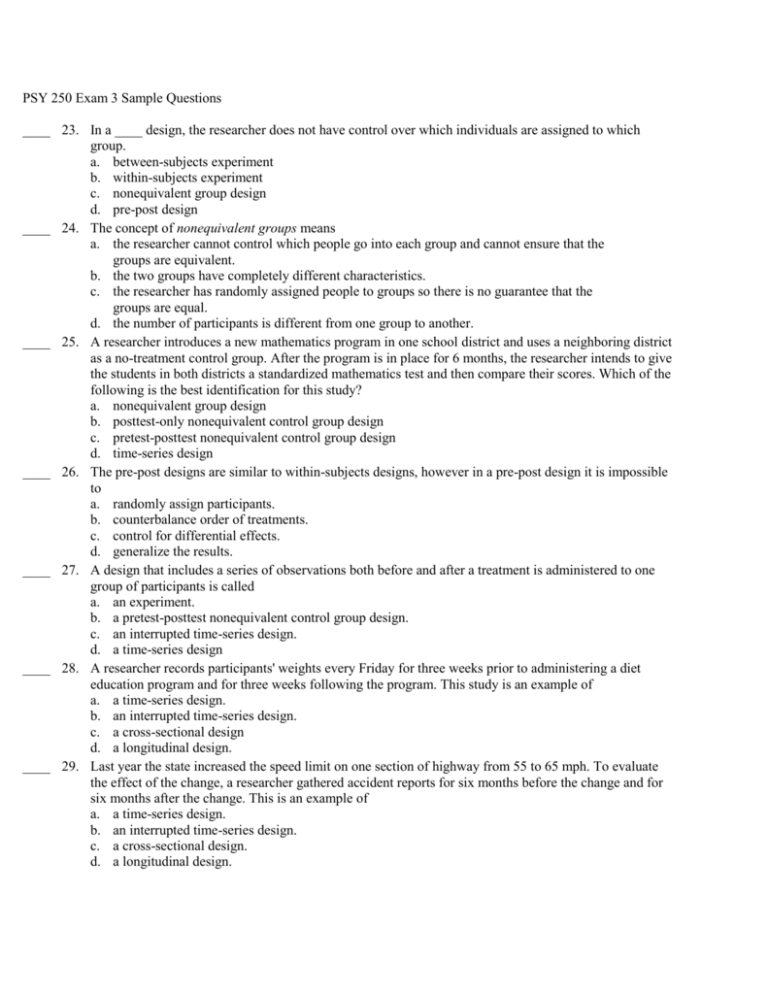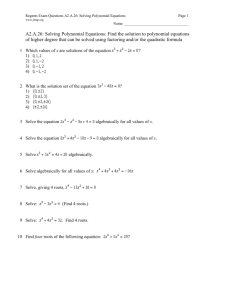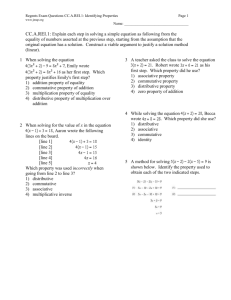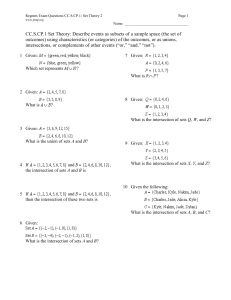Answer Section - Dr. Jennifer Vonk
advertisement

PSY 250 Exam 3 Sample Questions ____ 23. In a ____ design, the researcher does not have control over which individuals are assigned to which group. a. between-subjects experiment b. within-subjects experiment c. nonequivalent group design d. pre-post design ____ 24. The concept of nonequivalent groups means a. the researcher cannot control which people go into each group and cannot ensure that the groups are equivalent. b. the two groups have completely different characteristics. c. the researcher has randomly assigned people to groups so there is no guarantee that the groups are equal. d. the number of participants is different from one group to another. ____ 25. A researcher introduces a new mathematics program in one school district and uses a neighboring district as a no-treatment control group. After the program is in place for 6 months, the researcher intends to give the students in both districts a standardized mathematics test and then compare their scores. Which of the following is the best identification for this study? a. nonequivalent group design b. posttest-only nonequivalent control group design c. pretest-posttest nonequivalent control group design d. time-series design ____ 26. The pre-post designs are similar to within-subjects designs, however in a pre-post design it is impossible to a. randomly assign participants. b. counterbalance order of treatments. c. control for differential effects. d. generalize the results. ____ 27. A design that includes a series of observations both before and after a treatment is administered to one group of participants is called a. an experiment. b. a pretest-posttest nonequivalent control group design. c. an interrupted time-series design. d. a time-series design ____ 28. A researcher records participants' weights every Friday for three weeks prior to administering a diet education program and for three weeks following the program. This study is an example of a. a time-series design. b. an interrupted time-series design. c. a cross-sectional design d. a longitudinal design. ____ 29. Last year the state increased the speed limit on one section of highway from 55 to 65 mph. To evaluate the effect of the change, a researcher gathered accident reports for six months before the change and for six months after the change. This is an example of a. a time-series design. b. an interrupted time-series design. c. a cross-sectional design. d. a longitudinal design. ____ 30. A research study that evaluates developmental changes by examining different groups of individuals representing different ages, is called a. a time-series design. b. an interrupted time-series design. c. a cross-sectional design. d. a longitudinal design. ____ 31. A research study that evaluates developmental changes by examining the same group of individuals at different times in their lives is called a. a time-series design. b. an interrupted time-series design. c. a cross-sectional design. d. a longitudinal design. ____ 32. How many independent variables are there in an experimental two-factor design? a. 1 b. 2 c. 3 d. 4 ____ 33. A research study comparing problem solving scores obtained under three different levels of temperature would be called a ____. a. single-factor design b. two-factor design c. three-factor design d. factorial design ____ 34. In a 3 X 2 X 2 factorial design, how many levels of the third factor are there? a. 2 b. 3 c. 4 d. 8 ____ 35. The advantage of using a two-factor design rather than two single factor designs is to a. save time. b. find an interaction between the independent variables. c. find the main effects. d. check the manipulation. ____ 36. In a matrix representing the structure of a factorial design, the differences between the overall column means define a. the main effect for one factor. b. the interaction between the factors. c. the main effect and the interaction between the factors. d. nothing. ____ 37. How many main effects are there in a 2 X 2 X 2 factorial design? a. 2 b. 3 c. 6 d. 8 ____ 38. In a factorial design, an interaction between the factors occurs whenever a. the mean differences between the cells are not explained by the main effects. b. the mean differences between the cells are explained by the main effects. c. there are differences between the overall column means. d. there are differences between the overall row means. ____ 39. If the means for a two-factor study are displayed in a graph and the lines in the graph are perfectly parallel, then what can you conclude about the main effects and interaction? a. There is no main effect for either of the two factors. b. There is a main effect for both of the two factors. c. There is no interaction between factors. d. There is an interaction between factors. ____ 40. The warning label on a blood-pressure medication states that the medicine should be taken between meals because the presence of food in the stomach modifies the effect of the medicine. If the effects of the medicine were evaluated in a two-factor study comparing food versus no food (factor 1), and medicine versus no medicine (factor 2), then what pattern of main effects and interaction should appear in the data? a. There should be a main effect for both factors and an interaction. b. There should be a main effect for both factors but no interaction. c. There should be no main effect for either factor but there should be an interaction. d. You cannot predict the main effects but there definitely should be an interaction. ____ 41. A clinician claims that the effectiveness of a new treatment varies depending on the gender of the client. Specifically, the new treatment has been shown to be very effective for females, but the treatment has little or no effect for males. In this example, a. there is an interaction between the treatment and client's gender. b. there is no interaction between the treatment and client's gender. c. there is no main effect of treatment. d. there is no main effect of gender. ____ 42. The goal of the correlational research strategy is a. to examine and describe the relationship between variables. b. to examine and describe the causal relationship between variables. c. to describe an individual person or patient in great detail. d. to describe a variable (or variables) as they exist naturally. ____ 43. In a correlational study, commonly, a. one variable is measured. b. two variables are measured. c. one individual is described in great detail. d. one individual is treated. ____ 44. A researcher watches children on a playground to obtain measurements of their level of activity. Then the researcher watches the children's caregivers on the playground to obtain measurements of their level of verbal reprimanding of children. The researcher hopes to demonstrate that the caregivers verbal reprimanding is related to children's activity level. This researcher is using the a. descriptive research strategy. b. correlational research strategy. c. experimental research strategy. d. scientific research strategy. ____ 45. A college professor reports that students who finish exams early tend to get better grades than students who hold on to exams until the last possible moment. The correlation between exam score and amount of time spent on the exam is an example of a. a positive correlation. b. a negative correlation. c. a correlation near zero. d. a correlation near one. ____ 46. A negative value for a correlation indicates ____. a. a much stronger relationship than if the correlation were positive b. a much weaker relationship than if the correlation were positive ____ 47. ____ 48. ____ 49. ____ 50. ____ 51. ____ 52. ____ 53. c. increases in X tend to be accompanied by increases in Y d. increases in X tend to be accompanied by decreases in Y The Spearman correlation measures a. the degree to which the relationship is consistently one directional. b. the degree of linear relationship. c. the degree of curvilinear relationship. d. the degree of monotonic relationship. A professor reports that the final grades for her students are almost perfectly predicted by their scores on the first exam. The correlation between scores on the first exam and final grades is an example of a. a positive correlation. b. a negative correlation. c. a correlation near zero. d. a correlation near one. When students apply to colleges, they usually are required to submit SAT scores along with their applications. College officials know that there is a good relationship between scores on the SAT and success in college. In this situation, success in college is the a. predictor variable. b. criterion variable. c. dependent variable. d. independent variable. The results from a correlational study show a positive relationship between aggressive behavior for 6year-old children and the amount of violence they watch on television. Based on this relationship, which of the following conclusions is justified? a. Decreasing the amount of violence that the children see on TV will reduce their aggressive behavior. b. Increasing the amount of violence that the children see on TV will increase their aggressive behavior. c. Children who watch more TV violence tend to exhibit more aggressive behavior. d. All of the other options are justified conclusions. A researcher reports an inverse relationship between weight and exercise level for a group of 8-year-old children (greater weight is associated with less exercise). However, the researcher suspects that the children's rate of metabolism may be responsible for the relationship. That is, children with higher metabolism exercise more and weigh less than children with lower metabolism. This is an example of a. the third-variable problem. b. the directionality problem. c. the reversal problem. d. the criterion problem. A researcher reports a positive relationship between sugar consumption and activity level for a group of 8-year-old children. However, the researcher cannot be sure whether the extra sugar is causing the children to be more active or whether the extra activity is causing the children to eat more sugar. This is an example of a. the third-variable problem. b. the directionality problem. c. the reversal problem. d. the criterion problem. In the observational study of adolescents at the mall, you count the number of social interaction behaviors that occur within a given time interval. This is an example of the ____ method of quantifying behavior. a. frequency b. duration ____ 54. ____ 55. ____ 56. ____ 57. ____ 58. ____ 59. ____ 60. ____ 61. ____ 62. c. interval d. behavior counting In an observational study of autistic children, you record how much time each child spends playing alone during a 30 minute observation period. This is an example of the ____ method of quantifying behavior. a. frequency b. duration c. interval d. behavior counting A researcher watches children on a playground to obtain measurements of their level of aggression. This researcher is using a. naturalistic observation. b. participant observation. c. contrived observation. d. unstructured observation. A researcher joins a religious cult in order to observe their behaviors. This researcher is using a. naturalistic observation. b. participant observation. c. contrived observation. d. unstructured observation. In general, behavioral observation is very time consuming. However, this problem is greatly reduced by using a. participant observation. b. naturalistic observation. c. contrived observation. d. case study research. A drawback to an open-ended question is that a. the responses obtained may be difficult to code and analyze. b. it is more difficult to construct than other types of items. c. it may place too many restrictions on the participant's response. d. the other three choices are all drawbacks. What type of question allows participants the greatest flexibility in deciding how to answer? a. open-ended b. restricted c. rating scale d. physiological Nonresponse bias is a problem associated primarily with surveys administered a. by mail. b. by telephone. c. in person to groups. d. in person to individuals. In general, the case study design tends to have a. high internal validity and low external validity. b. high internal validity and high external validity. c. low internal validity and high external validity. d. low internal validity and low external validity. An advantage of single-subject designs is that a. they can be used with one participant. b. they are valuable in clinical settings. c. they allow for an experiment to be conducted on a single individual. ____ 63. ____ 64. ____ 65. ____ 66. ____ 67. ____ 68. ____ 69. ____ 70. ____ 71. d. the other three choices are all advantages of single-subject designs. Like other experimental designs, single-subject designs a. provide data that can be evaluated with traditional tests for significance. b. are capable of determining cause and effect relationships. c. involve a series of observations over time. d. provide a detailed description of a single individual. In single-subject research (specifically in phase-change designs), a phase consists of a. a series of observations conducted over time. b. a series of observations of the same individual. c. a series of observations under the same conditions. d. the other three choices are all components of a phase. The pattern within a phase can be described in terms of a. level. b. trend. c. level or trend. d. mean. In single-subject research, the stability of the data refers to a. clear differences between treatment phases and baseline phases. b. how quickly the scores show a change between one phase and the next. c. the magnitude of the change in scores between one phase and the next. d. the consistency of the level or the trend within a phase. In single-subject research, unstable data a. make differences between treatment phases and baseline phases clear. b. make it impossible to define a pattern within a phase. c. make it impossible to determine whether a change in phases produces a change in pattern. d. make it impossible to define a pattern within a phase and make it impossible to determine whether a change in phases produces a change in pattern. In a graph of single-subject research data, a clear indication of a treatment effect is a. a continuation of the same mean level from one phase to the next. b. a continuation of a clear trend from one phase to the next. c. a gradual change in behavior that becomes clear several observations after the treatment is initiated. d. a clear and immediate change in either the level or trend when the treatment is initiated. A researcher has developed a device to prevent snoring. The device works immediately when it is put on but it has no lasting effect when it is removed. If a researcher decided to evaluate this device with a single-subject design, which design would be appropriate? a. ABAB design b. multiple-baseline design c. alternating treatments design d. changing criterion design In an ABAB design the critical element for demonstrating that the treatment causes changes in behavior is a. the change from the initial baseline to the initial treatment phase. b. the return to baseline after the first treatment phase. c. the second treatment phase that replicates the first. d. the consistency of the pattern of scores obtained in the two baseline phases. In a dismantling design, the researcher a. withdraws the treatment gradually by removing one component at a time. b. changes the measurement from one behavior to another during the treatment phase to determine which behaviors are influenced by the treatment. c. uses a series of different treatment phases to compare the effectiveness of several different treatments. d. adds or subtracts one component of the treatment from one phase to the next to determine how the different components of a treatment contribute to its effectiveness. ____ 72. The main difference between a multiple-baseline design and an ABAB design is a. the ABAB design is used when the treatment has a permanent or long-lasting effect. b. the ABAB design is used when the treatment has an immediate but temporary effect. c. the ABAB design does not require a stable baseline phase. d. the ABAB design reduces the probability that the result is just chance or coincidence. ____ 73. A stop-smoking program requires participants to monitor their smoking and to control the number of cigarettes they smoke. The program sets a target for the number of cigarettes a participant is allowed each day, and the target number is changed every three days. Although the target moves up and down, it gradually reduces toward a goal of zero smoking after six weeks. If this program were evaluated using a single-subject design, which design would be appropriate? a. ABAB design b. multiple-baseline design c. alternating-treatments design d. changing-criterion design ____ 74. During a one-hour session, a therapist switches back and forth between periods of personal comments aimed directly at the patient (You seem to be quite happy today.) and periods of impersonal comments (Happiness often is associated with sunny weather.). The therapist records how many self-revealing statements the patient makes during each period to see if there are any consistent differences. The researcher is using a(n) a. ABAB design. b. multiple-baseline design. c. alternating-treatments design. d. changing-criterion design. Answer Section 23. 24. 25. 26. 27. 28. 29. 30. 31. 32. 33. 34. 35. 36. 37. 38. 39. 40. 41. 42. 43. 44. 45. 46. 47. 48. 49. 50. 51. 52. 53. 54. 55. 56. 57. 58. 59. 60. 61. 62. 63. 64. 65. 66. 67. ANS: ANS: ANS: ANS: ANS: ANS: ANS: ANS: ANS: ANS: ANS: ANS: ANS: ANS: ANS: ANS: ANS: ANS: ANS: ANS: ANS: ANS: ANS: ANS: ANS: ANS: ANS: ANS: ANS: ANS: ANS: ANS: ANS: ANS: ANS: ANS: ANS: ANS: ANS: ANS: ANS: ANS: ANS: ANS: ANS: C A B B D A B C D B A A B A B A C D A A B B B D D D B C A B A B A B C A A A D D B D C D D REF: REF: REF: REF: REF: REF: REF: REF: REF: REF: REF: REF: REF: REF: REF: REF: REF: REF: REF: REF: REF: REF: REF: REF: REF: REF: REF: REF: REF: REF: REF: REF: REF: REF: REF: REF: REF: REF: REF: REF: REF: REF: REF: REF: REF: 251 252 254-256 258 259 259 259 264 268 276 276 277 277 278 293 278 283 281 282 308 308 308 310 310 311 311 314 316 316 317 325 325 328 328 330 333 333 339 346 351 351 353 354-355 355-356 356 OBJ: www OBJ: www OBJ: www OBJ: www OBJ: www OBJ: www OBJ: www OBJ: www 68. 69. 70. 71. 72. 73. 74. ANS: ANS: ANS: ANS: ANS: ANS: ANS: D A C D B D C REF: REF: REF: REF: REF: REF: REF: 360 362 364 368 371 375 375 OBJ: www OBJ: www







